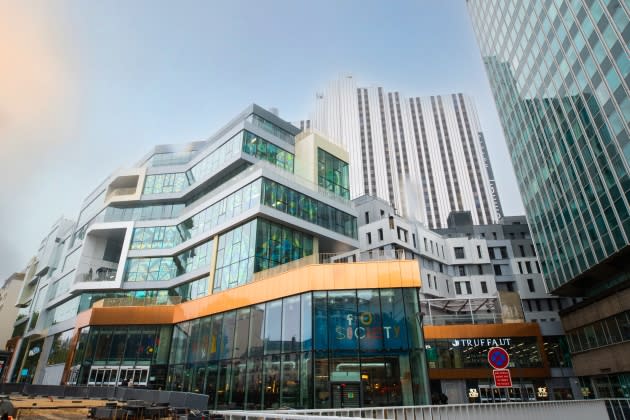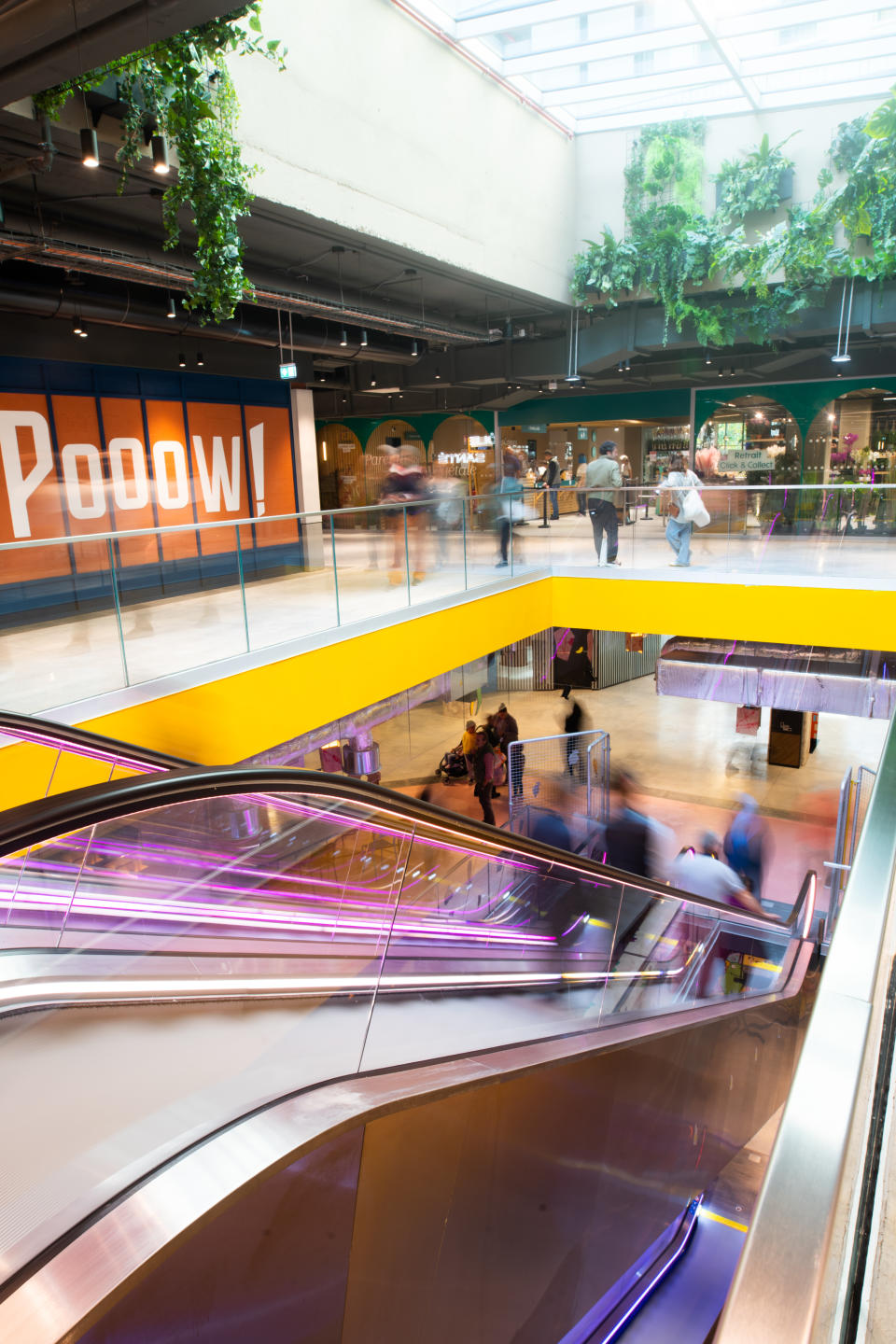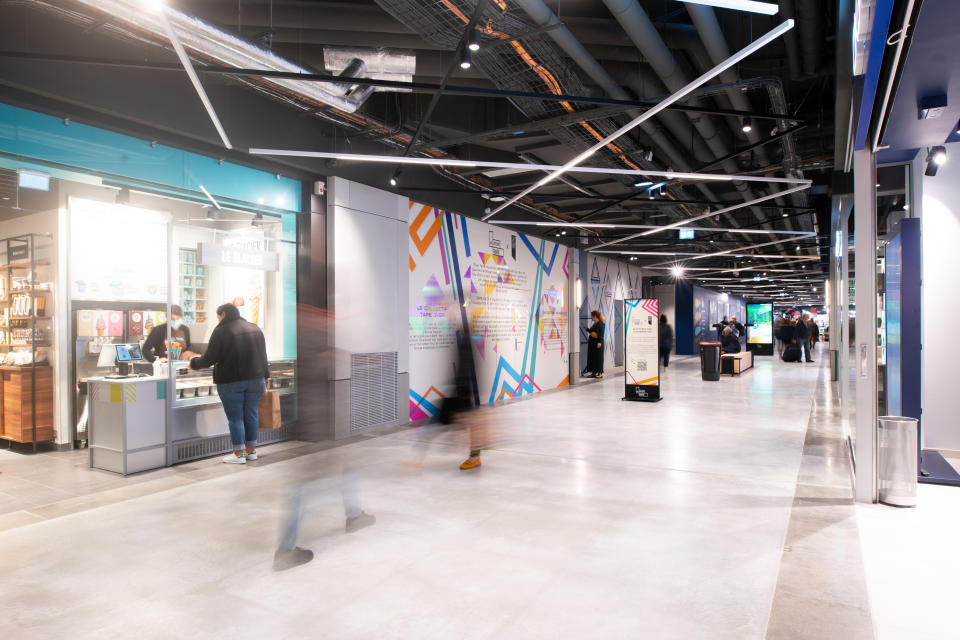Westfield Unveils Mixed-use Mall in Paris
- Oops!Something went wrong.Please try again later.

PARIS — A new mixed-use center steps from the bustling Montparnasse train station hopes to revitalize the utilitarian district around the only skyscraper in Paris.
Les Ateliers Gaîté opened its doors Wednesday following a five-year, 500 million euro renovation from global shopping destination developer Unibail-Rodamco-Westfield. Dutch architecture star Winy Maas and his firm MVRDV headed up the project, which revamped an existing mixed-use office and shopping center.
More from WWD
It boasts 310,100 square feet of shopping, 140,000 square feet of office space, and a food court, combined with 62 social housing units, a city library, and a day care center — all anchored by the 950-room Pullman hotel and conference center.
The mixed-use style is emblematic of what Westfield wants to achieve, according to URW chief executive officer Jean-Marc Tritant.
“It’s a very good illustration of the philosophy that we have developed over time to regenerate the city, from and within the city. In some ways this is a laboratory in how you combine the different types of usage,” said Tritant.
Maas reinvisioned the landmark Vandamme stacked-box building, originally designed by French architect Pierre Dufau, which adhered to the early ’70s vision that the car was king. The block sat as an “urban island” surrounded by streets, but became increasingly disconnected from the neighborhood.
He added two additional street-level entrances, removed street-level parking in favor of a bike path, created more pedestrian crossings and added a green square. The new design retained up to 70 percent of the original structure, reenvisioning it with industrial touches, exposed air ducts, cement slab floors and lots of natural wood touches.
Les Ateliers Gaîté is connected directly to one metro station and steps away from the Montparnasse train station, the fourth busiest in the Paris region. URW expects nearly 8 million visitors a year.
The shopping area is envisioned as a spot to fulfill neighborhood needs, with a bakery, wine store, hardware shop and fitness center alongside shops from local artisans, with Claire’s being the sole international mall chain store.
“This is a place that is more done for the Parisians and for the people that are living around, walking around or using the railway station. We have created this environment where people live, work, shop and play,” Tritant said.
He noted the group has recently worked on similar shopping center revitalization projects with La Part-Dieu in Lyon, France and Überseequartier in Hamburg, Germany, and operates in Century City and Topanga Canyon in Los Angeles among 82 of its global properties.
However the Paris project is aimed less at destination shopping and more natural integration with the city, he said.
Tritant said while it might end up attracting tourists using the train station, he does not foresee it attracting the same luxury clientele as the Avenue des Champs-Élysées. In particular, he highlighted the food court, billed as the largest in Europe at 38,000 square feet, as a “tourist” destination for Parisians from other neighborhoods to explore within their own city.

One of the biggest challenges behind the five-year redevelopment was getting various zoning laws in line. Tritant noted that current laws see buildings as separate entities — an apartment building and an office are strictly siloed, for example — and need a reexamination.
“This is where the difficulty has been — in the regulations context,” he said. “This is where the complexities are, how do you make this evolve, knowing that we were starting not from scratch but from an existing property.”
URW worked with the city to redefine spaces and create a more pedestrian-friendly neighborhood.
Maas set out to reintegrate the structure with wide sidewalks and welcoming open windows. During a tour Wednesday, city workers were still placing stones for the expansive space and terrace, envisioned to attract locals.
“Mixed use is a necessity and an obligation for our future cities, our cities will continue to grow. And this mixed use helps us to be flexible in terms of economy, in terms of synergy, because elements can help each other, and it works socially, because Paris has almost 200 nationalities and maybe 400 different cultures, and it welcomes cultures in the widest sense,” Maas said.
“Density is an important element for our cities to avoid future destruction of our countryside [with low-density sprawl]. So you see how different demands can come in with the existing structure,” he added. Rather than demolition and a completely new build, he said smaller tweaks allowed him to keep up to 70 percent of the existing structure.
With Maas’s MVRDV, Westfield is also in the running for a mixed-use redevelopment project in Paris’ office park and steel slab suburb of La Défense. Tritant hopes Les Ateliers Gaîté can demonstrate what is possible.
“This is more about the way we live now and the way we want to live,” he added.


